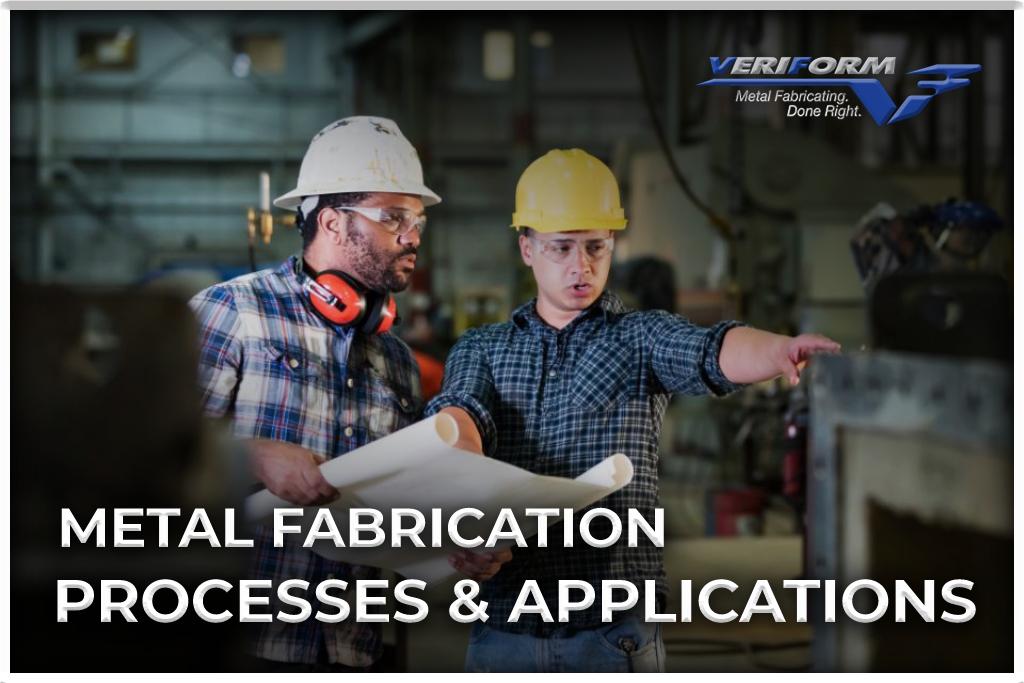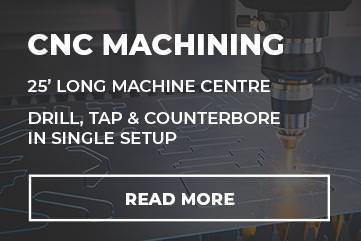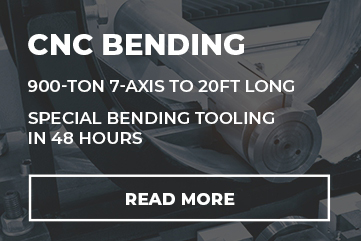News
Types of Metal Fabrication Processes & Applications

Metal Fabrication Process: An Overview
Metal manufacturing is an essential industry that creates a vast array of custom metal fabricated products, from automotive components to construction materials. This comprehensive guide will explore various types of metal fabrication, including the use of press brakes, stainless steel, and other manufacturing processes to transform raw materials into functional and aesthetic products.
Understanding Metal Fabrication
At its core, the metal fabrication process involves a series of techniques to shape metal into the desired form. Some common types of metal fabrication include cutting, bending, and welding, which work together to create a custom piece of metal. The choice of methods and the sequence in which they are applied depends on the fabricated product’s design, material, and end-use.
Types of Metal Fabrication
There are several types of metal fabrication processes, each suited to different materials and applications. Some common processes include:
- Sheet Metal Fabrication: Involves shaping metal sheets into various forms using cutting, bending, and joining techniques. Sheet metal fabrication is widely used in the automotive, aerospace, and construction industries.
- Machining: A subtractive process that removes material from a workpiece using tools such as lathes, mills, and drills. Machining is commonly used to create precision components and intricate details.
- Welding: The process of joining metal pieces together by melting and fusing them at the joint. There are various types of welding, such as TIG, MIG, and arc welding, each with its advantages and applications.
- Cutting: Cutting processes, including plasma cutting and laser cutting, are employed to shape the metal. Plasma cutting uses a high-velocity jet of ionized gas, while laser cutting employs a focused beam of light to cut through the metal.
Metal Fabrication Workflow: A Detailed Look
The metal fabrication workflow is a complex and multi-step process, ensuring that the final product meets the desired specifications and performance standards. This comprehensive overview breaks down each stage of the metal fabrication workflow to provide a better understanding of the entire process.
1. Design and Engineering:
The first step in the metal fabrication process is the creation of detailed plans, blueprints, or computer-aided designs (CAD) based on the client’s requirements. These designs dictate the materials, dimensions, and manufacturing processes necessary to create the final product. Engineers may use various software tools to optimize and analyze the design’s structural integrity and performance.
2. Material Sourcing:
he appropriate materials are sourced once the design is finalized. Factors such as strength, durability, weight, and corrosion resistance must be considered when selecting the ideal material for the project. Common materials used in fabrication include stainless steel, aluminum, and carbon steel.
3. Material Preparation:
Before the fabrication process begins, materials must be prepared to ensure they meet the required specifications. This stage involves processes including cutting large-scale metal sheets to size, cleaning surfaces to remove dirt, grease, or contaminants, and applying protective coatings if necessary.
4. Fabrication Techniques:
The main fabrication stage involves various techniques such as cutting, bending, and welding to shape the metal into the desired form. Cutting methods like plasma and laser cutting are used to create intricate shapes and patterns. Press brakes are utilized to bend metal sheets accurately, while different types of welding, such as TIG and MIG, are employed to join metal pieces securely.
5. Assembly:
In some cases, the fabrication process involves assembling multiple components to create a more complex product. This step requires careful alignment and joining of parts to ensure proper fit and functionality. Bolting, riveting, and adhesive bonding are some of the techniques used for assembly.
6. Quality Control and Inspection:
Quality control measures are implemented throughout fabrication to ensure the final product meets the required specifications and industry standards. This involves conducting visual inspections, dimensional checks, and non-destructive testing methods like radiography and ultrasonic testing to detect defects or imperfections in the final product without causing damage.
7. Finishing and Post-Processing:
After the fabrication process is complete, the product may undergo various finishing and post-processing techniques to improve its appearance, performance, or longevity. These processes can include painting, powder coating, anodizing, galvanizing, or polishing. The choice of finishing technique depends on the desired look and protective qualities of the final product. Some materials may also require heat treatment to improve their mechanical properties or stress relief.
8. Packaging and Delivery:
Once the final product has been fabricated, inspected, and finished, it is carefully packaged for transportation and delivery to the client or end user. Proper packaging is essential to protect the product from damage during transit and ensure that it arrives in pristine condition. The delivery process can involve local or international shipping, depending on the project’s scope and requirements.
Learn More About The Basics of Metal Fabrication
By understanding the detailed workflow involved in metal fabrication, from design and engineering to finishing and delivery, you can better appreciate the skill, precision, and expertise required to create high-quality metal products. Each stage plays a vital role in ensuring that the final product meets the desired specifications and performs optimally in its intended application. To learn more about the basics of metal fabrication, check out this article on metal fabrication basics.
Choosing the Right Fabrication Process
Selecting the appropriate fabrication process for your project is essential to ensure its success. Factors to consider include the material type, design complexity, production volume, budget, desired finish and appearance, and the expertise and equipment available. Evaluating these factors will help you make the right choice for your metal fabrication project.
Tools and Equipment Used in Fabrication Shops
Fabrication shops employ various tools and equipment to execute different processes, such as press brakes for bending, plasma cutters for cutting, and welding machines for joining metal pieces. In addition, several hand tools, such as deburring tools, are also used during the fabrication process to clean and finish metal components. To learn more about the tools used in metal fabrication, you can read this article on metal fabrication tools used by fabricators.
Safety Practices in Metal Fabrication
Safety is paramount in any fabrication environment. Fabrication shops must adhere to strict safety practices, such as wearing proper protective equipment, maintaining a clean and organized workspace, and ensuring that employees receive adequate training on the safe use of tools and equipment. For more information on safety practices in metal fabrication, check out this article on common metal fabrication safety practices.
Custom Metal Fabrication Advantages and Disadvantages
Custom metal fabricated products offer several advantages, such as the ability to create unique designs tailored to specific requirements and the flexibility to adjust the fabrication process as needed. However, custom metal fabrication can also have some drawbacks, such as increased costs and longer lead times compared to mass-produced items. To learn more about the pros and cons of custom metal fabrication, read this article on the advantages and disadvantages of custom metal fabrication.
Materials Used in Metal Fabrication
Various materials can be used in metal fabrication, depending on the desired properties and applications of the final product. Some common materials include:
- Stainless Steel: Known for its corrosion resistance, strength, and durability, stainless steel is widely used in a range of applications, including food processing, medical devices, and automotive parts. For more information on stainless steel fabrication services, visit this stainless steel fabrication services landing page.
- Aluminum: Lightweight and highly versatile, aluminum is commonly used in the aerospace, automotive, and consumer goods industries. Its excellent corrosion resistance and good strength-to-weight ratio make it an attractive choice for many applications. For more information on aluminum metal fabrication services, visit this aluminum metal fabrication services landing page.
- Carbon Steel: Carbon steel offers excellent strength and durability at a lower cost than other materials, making it a popular choice for structural applications, automotive components, and industrial equipment. For more information on carbon steel metal fabrication services, visit this carbon steel metal fabrication services landing page.
Conclusion
Metal fabrication is a complex process that involves various techniques and materials to create custom metal products. By understanding the different types of metal fabrication, the tools and equipment used in fabrication shops, and the materials suitable for different applications, you can make informed decisions for your next metal fabrication project.
Frequently Asked Questions
Q1: What is the difference between plasma cutting and laser cutting?
Plasma cutting uses a high-velocity jet of ionized gas to cut through metal, while laser cutting employs a focused beam of light. Both methods are used for cutting metal, but they have different advantages and applications depending on factors like material type, thickness, and required precision.
Q2: What are the most common types of welding techniques?
Some common types of welding techniques include TIG (tungsten inert gas) welding, MIG (metal inert gas) welding, and arc welding. Each welding method has its advantages and is suitable for different materials and applications.
Q3: Can any type of metal be used in the fabrication process?
While many metals can be used in the fabrication process, some materials are more suitable for specific applications due to their properties, such as strength, corrosion resistance, and ductility. It’s essential to choose the right material based on your project’s requirements.
Q4: How can I ensure the quality of my fabricated metal products?
Quality control measures, such as inspections and non-destructive testing methods, should be in place throughout the fabrication process to ensure the final product meets the required specifications and industry standards.
Q5: What are some common applications of metal fabrication?
Metal fabrication is used in various industries, such as automotive, aerospace, construction, consumer goods, and medical devices. Some examples of fabricated metal products include structural components, automotive parts, and consumer electronics.








